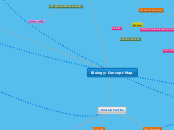jonka Abbigail Garza 10 vuotta sitten
983
Biology: Concept Map

jonka Abbigail Garza 10 vuotta sitten
983

Lisää tämän kaltaisia
Begins with mRNA
Binds to anti codon
Contains tRNA
contains amino acids
make protein
Can fit two ribosomes
Contains codons
starts with DNA
unzipped by RNA polymerase
Creates mRNA
Primase
Starting point for DNA synthesis
Synthesizes short RNA primers
SSB
Keeps DNA strands separated
DNA polymerase
adds nucleotides
in 5'->3' direction
Topoisomerase
Prevents DNA from recoiling
DNA helicase
Replication fork is formed
lagging strand
discontinuously synthesised
RNA primase creates
RNA primer
DNA polymerase replicates primer
Okazaki fragments are linked
By
DNA Ligase
forming leading strand
by DNA polymerase
RNA primase synthesizes RNA primer
strand is continuously synthesized
unzips DNA helix
Created
Adenylyl Cyclase
G-Protien linked receptor(in membrane)
Glycogen breakdown with epinephrine
Example
Cyclic AMP (cAMP)
allows
Calcium Ions
Into
Cytoplasm
From
Mitochondrial Matrix
Activates
from ATP
Reversal Enzymes
Protein Phosphotases
Signal Molecule
Ligand
3 Steps
Response
Triggers
Specific cellular response
Regulates
Nuclear transcription
Cytoplasmic Activity
Cell Metabolism
Transduction
2 Types
Single Step
Series of Change
Reception
Targets
Cell Detections
Protein then travels with cisternae
Is a specific vesicle
To the trans face
Protein exits and travels with a vesicle
Has a specific "tag"
Directed to the cytoplasm using a motor protein
Travels on microtubles
Arrives at the
Adds a carbohydrate group
Forms a glycoprotein
Which through a vesicle to the
SRP Receptor
binds to the
SRP protien
binds to
Protiens
to synthesize
RNA
use
Ribosomes
Contain
ER Sequence
Are found in
Cytosol